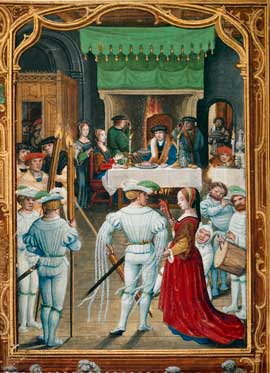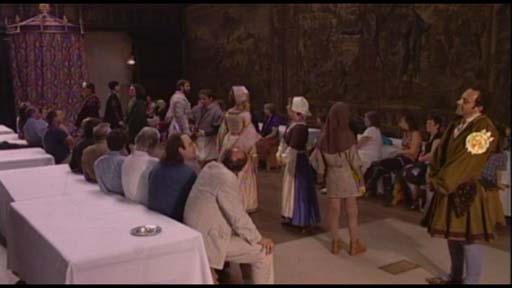Account of the entertainment for the French Ambassadors, 1518

Calendar scene for February: Feasting and dancing
Image taken from The Golf Book.
Originally published/produced in
S. Netherlands (Bruges), 1520-1530.
The following is an account from Hall's Chronicle describing a pageant that was performed in front of Lord Bonevet and the Bishop of Paris, who visited Henry's court in 1518. The purpose of the pageant was to use theatrical spectacle to celebrate the betrothal of Princess Mary to the Dauphin of France; a marriage meant to politically reconcile the English and the French after the wars of 1510-13.
The .viii. day of October at Grenewiche was song a solempne masse by the bishop of Durham, and after masse doctor Tunstal master of the Rolles, which after was bishop of London, made an eloquent proposicion in praise of the matrimony to be had betwene the Dolphyn and lady Mary: and all that day were the straungers feasted, and at night they were brought into the hall, where was a rock ful of al maner of stones, very artificially made, and on the top stood .v. trees, the first an Olive tree, on which hanged a shild of the armes of the Church of Rome : the .ii. a Pyneaple tree, with the armes of the Emperour : the .iii. a Roysyer with the armes of England : the .iiii. a braunche of Lylies, bearing the armes of Fraunce : and the .v. a Pomegranet tree, bearing the armes of Spayn : in token that al these .v. potentates were joined together in one league against the enemies of Christes [fayth] : and upon the middes of the Rock sate a fayre lady, richely appareled with a Dolphin in her lap. In this rock were ladies and gentlemen…and out of the cave in thesaid Rock came .x. knightes, armed at all poyntes, and faughte together a fayre tournay. And when they were severed and departed, the disguysers dissended from the rock, and daunced a great space: and sodeynly the rocke moved and receved the disguysers, and ymediatly closed again. Then entred a person called Reaport appareled in Crymosyn satyn full of tonges, sitting on a flyeng horse with wynges and fete of gold called, Pegasus. Thys person in Frenche declared the meaning of the rocke and the trees, and the Tournay.
References:
Edward Hall, The Union of the two noble and illustre families of Lancastre and Yorke (London, 1550) sig. l5r.










